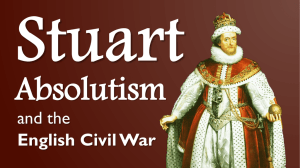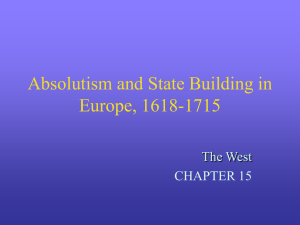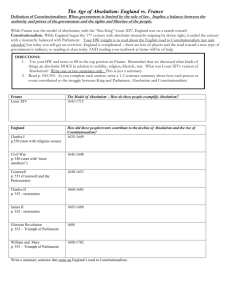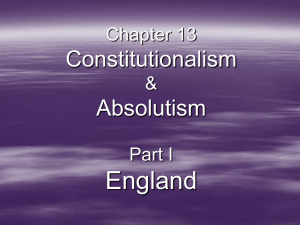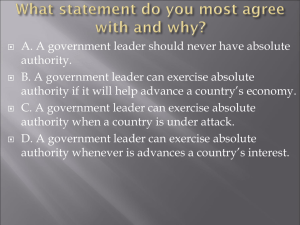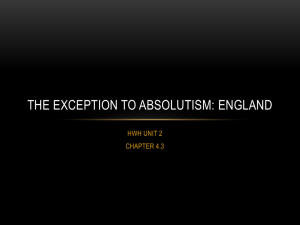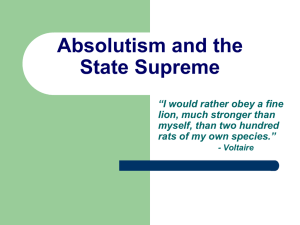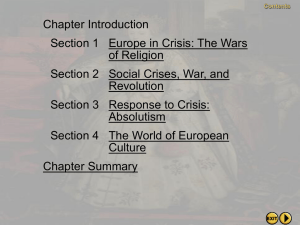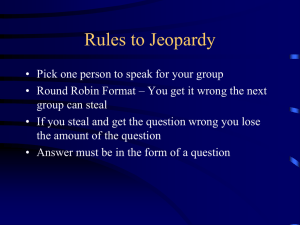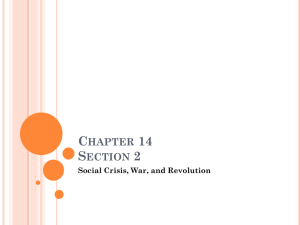Chapter 7: Crisis and Absolutism in Europe
advertisement
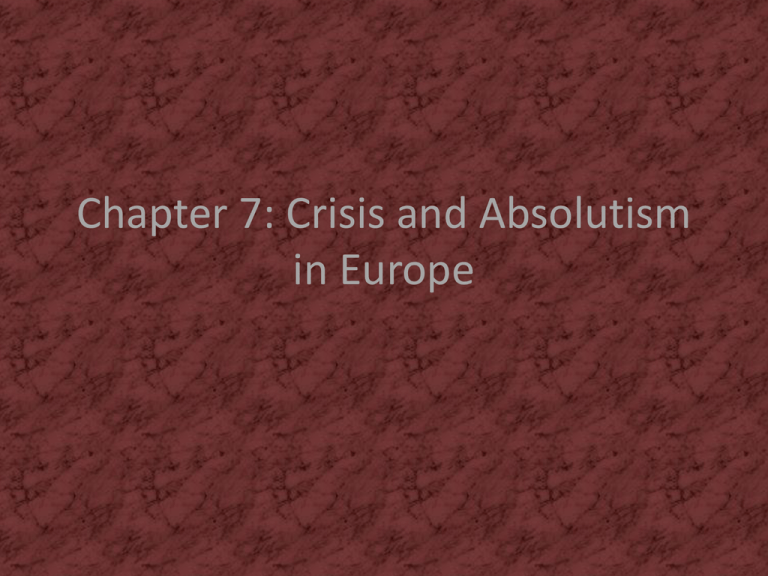
Chapter 7: Crisis and Absolutism in Europe Section 1: Europe in Crisis: The Wars of Religion • French Wars of Religion – Calvinism and Catholicism became highly combative religions, trying to win converts and eliminate the other’s authority. – Huguenots (French Protestants) converted several noble families (50%) which became a threat to the French king. – Battles rages for 30 years until Henry of Navarre became king (Henry IV). He issued the Edict of Nantes which declared Catholicism as the official religion but allowed the Huguenots to worship freely and hold public offices. • Philip II of Spain and Militant Catholicism – Consolidated the lands he inherited from his father – Spain, the Netherlands, and possessions in Italy and the Americas – To strengthen his control he insisted on strict conformity to Catholicism – He became a champion of Catholic causes; however, he would go bankrupt from spending too much on wars • England and Queen Elizabeth – Inherited the throne from her halfsister Mary Tudor, “Bloody Mary” – Established the Church of England as the official church – to keep people satisfied, the church followed a moderate Protestantism – Philip II of Spain tried to attack England with an armada – after failing, most of the ships sank on their way home Section 2: Social Crises, War, and Revolution • Economic and Social Crises – During the late 1500’s and early 1600’s • Inflation, or rising prices: caused by the influx of gold and silver from the Americas • Growing population increased the demand for land and food, which caused prices to increase as well – By 1620 • Population began to decline because of warfare, plague, and famine • Thirty Years’ War – Religious disputes continued, even in Germany. • War broke out in 1618 because one group of protestants rebelled against the Hapsburgs who were the Holy Roman emperors • Most of the war was fought on German soil • All major European powers were involved with the exception of England • War ended with the Peace of Westphalia in 1648 – It stated that all German states could determine their own religion – Broke up the Holy Roman Empire • Revolutions in England – Several rebellions and wars broke out in England • Most famous one was the England Revolution – It was a struggle between the king and Parliament to determine what role each would play in government – Kings thought they ruled by the divine right of kings (receive power from God and only responsible to God) – Parliament disagreed – they believed that the two groups should rule together • Civil War – Fought between the Cavaliers (supporters of the king) and the Roundheads (members of Parliament and their supporters) – Parliament enlisted the help of Oliver Cromwell • Purged Parliament of anyone that did not support him and even had the king (Charles I) beheaded • After destroying the king and Parliament, he set up a military dictatorship • Restoration – Cromwell ruled until his death – Parliament restored the monarchy with Charles II – James II, brother to Charles, took the throne upon Charles’ death • He was a devout Catholic which made religion a conflict once more between the monarchy and Parliament • Glorious Revolution – Mary, James’ daughter, and her husband William invaded England to take control – Almost no bloodshed so it was called a “Glorious Revolution” – Parliament offered the throne to William and Mary • Established a Bill of Rights which created a system of government based on the rule of law and a freely elected Parliament • Toleration Act: granted protestants, not Catholics, the right to free public worship Section 3: Response to Crisis: Absolutism • Absolutism was Europe’s answer to the unstable governments. – King Louis XIV’s reign is regarded as the best example of absolutism in 17th century. • Absolutism is tied to the idea of the divine right of kings. • Louis XIV came to power at the age of 4. His chief minister was Cardinal Mazarin. Louis would take complete control at the age of 23 after Mazarin’s death. • He called himself the “Sun King” – he saw himself as the source of light for his people. • He established the royal court at Versailles. This gave him the ability to stay at home while keeping an eye on the government officials. • King Louis XIV fought to keep Catholicism the official religion in France. He had several Protestant churches destroyed and closed their schools. • At the age of 73, he died, leaving France with severe debt from the construction of palaces, maintaining his royal court, and financing several wars. • He left the throne to his 5 year old great-grandson. • In Russia, Ivan IV became the first ruler to take the title of czar after crushing the nobility known as the boyars. • He was known as Ivan the Terrible because of his ruthless deeds. (He stabbed his own son to death.) • Upon his death, the national assembly chose Michael Romanov as the new czar in 1613. (The Romanov dynasty would last until 1917. ) • One of the greatest czars of the Romanov dynasty was Peter the Great. • He ruled with absolutism. • Under his rule, Russia became a great military power. Section 4: The World of European Culture • The artistic Renaissance ended with the movement known as Mannerism. – It focused on showing strong emotions such as suffering and tension amongst the subjects • The baroque movement eventually replaced mannerism. • The art and architecture reflected the search for power that was part of the 17th century. Buildings were highly decorated and elaborate. • In literature, three people stood out in Europe. – England : William Shakespeare is best known for writing plays even though he was an actor and theater owner. He wrote tragedies and comedies. – Spain: Lope de Vega wrote over 1,500 plays that were witty, action-packed, and realistic. Miguel de Cervantes wrote one of the greatest literary works of all time called Don Quixote. • In politics, John Locke argued against the absolute rule of one person. He believed people were born with natural rights that should be protected by the government. Even though he was not an advocate for democracy, his ideas can be found in the American Declaration of Independence and the United States Constitution.

